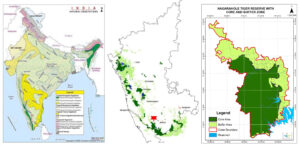Table of Contents
Nagahole Tiger Reserve
Nagarhole Tiger Reserve is a national park and tiger reserve located in the state of Karnataka, India. It is situated in the southwestern part of Karnataka, bordering the Bandipur Tiger Reserve to the south and the Kabini River to the north.
The park was established in 1955 as a wildlife sanctuary and was later declared a national park in 1988. In 1999, it was declared a tiger reserve under the Project Tiger initiative.
Nagarhole Tiger Reserve is known for its tiger population, and the park has been successful in conserving and protecting this endangered species. According to the latest census conducted in 2021, there are around 73 tigers in the reserve.
Read about: Tiger Reserves in India
Nagarhole Tiger Reserve Landscape
The park is situated in the Western Ghats, a mountain range that runs parallel to the western coast of India. The park covers an area of approximately 643 square kilometers and is characterized by dense forests, grassy swamps, and several rivers and streams. The park’s topography is characterized by a mix of forested hills, valleys, and streams, with the highest point in the park being Brahmagiri peak, which stands at an elevation of 1,608 meters above sea level.
The Kabini River, a tributary of the Cauvery River, flows through the northern part of the park and forms the boundary between Nagarhole and Bandipur National Park. The river is an important water source for the park’s flora and fauna, and also provides opportunities for activities such as boating and fishing. The park is also home to several smaller streams and water bodies, including the Lakshmana Tirtha River and the Moyar River, which flow through the southern and eastern parts of the park, respectively.
Read about: Pilibhit Tiger Reserve
Nagarhole Tiger Reserve Map
Here is a Map of Nagarhole Tiger Reserve given below:

Nagarhole Tiger Reserve Fauna
Nagarhole Tiger Reserve is known for its rich diversity of fauna, including several endangered and unique species of mammals, birds, reptiles, amphibians, fish, and insects.
| Fauna Category | Species Found | Unique Feature |
| Mammals | Bengal Tiger, Indian Elephant, Indian Bison, Indian Leopard, Sloth Bear, Wild Dog, Spotted Deer | Nagarhole Tiger Reserve is known for its tiger population, and the park has been successful in conserving and protecting this endangered species. The park is also home to other large mammals such as elephants, Indian bison, and sloth bears. |
| Birds | Indian Peafowl, Crested Hawk-Eagle, White-backed Vulture, Malabar Grey Hornbill, Streak-throated Woodpecker | The park is home to around 300 species of birds, including several species of raptors and woodpeckers. |
| Reptiles | Indian Rock Python, Common Krait, Russell’s Viper, Common Vine Snake, Indian Chameleon | Nagarhole Tiger Reserve has a rich variety of reptile species, with several venomous snake species found in the park. |
| Amphibians | Malabar Gliding Frog, Bullfrog, Asian Toad, Indian Tree Frog, Cane Toad | The park is home to several species of frogs and toads, including the Malabar Gliding Frog, which can glide up to 12 meters using its webbed feet. |
| Fish | Mahseer, Catfish, Tropheus | The Kabini River, which flows through the park, is home to several species of freshwater fish. |
| Insects | Common Indian Crow Butterfly, Blue Tiger Butterfly, Great Eggfly Butterfly, Indian Red Admiral Butterfly, Plain Tiger Butterfly | Nagarhole Tiger Reserve has a diverse range of butterfly species, with several species of brightly coloured and patterned butterflies found in the park. |
Read about: Sariska Tiger Reserve
Nagarhole Tiger Reserve Flora
Nagarhole Tiger Reserve boasts a diverse range of flora, including several species of trees, shrubs, climbers, grasses, and orchids. The park’s flora is an integral part of the ecosystem, providing food and shelter for the park’s diverse range of wildlife.
| Flora Category | Species Found | Unique Feature |
| Trees | Teak, Rosewood, Sandalwood, Indian Kino Tree, Indian Laurel, Flame of the Forest | Nagarhole Tiger Reserve is home to several species of trees, with teak and rosewood being the dominant species. Sandalwood, which is highly valued for its aromatic wood, is also found in the park. |
| Shrubs | Lantana, Indian Beech, Indian Gooseberry, Cluster Fig | The park has several species of shrubs, including Lantana, which is an invasive species in the park and poses a threat to the park’s biodiversity. |
| Climbers | Pepper Vine, Indian Trumpet Creeper, Wild Jasmine | Several species of climbers can be found in Nagarhole Tiger Reserve, with pepper vine being a notable species. |
| Grasses | Elephant Grass, Wild Sugarcane, Lemon Grass | The park has several species of grasses, with elephant grass being the dominant species. Lemon grass is also found in the park and is commonly used in Indian cuisine. |
| Orchids | Jewel Orchid, Bamboo Orchid, Ground Orchid, Spider Orchid | Several species of orchids can be found in Nagarhole Tiger Reserve, including jewel orchid and spider orchid. |
Read about: Parambikulam Tiger Reserve
Nagarhole Tiger Reserve Tourism
Nagarhole Tiger Reserve offers a unique and immersive wildlife experience to tourists. Visitors to the park can go on guided safaris to spot tigers, elephants, bison, and other wildlife species in their natural habitat. The park also has several trekking trails, which provide an opportunity for visitors to explore the park’s lush forests and scenic landscapes.
The best time to visit Nagarhole Tiger Reserve is from October to May when the weather is dry and pleasant, and wildlife sightings are more frequent. The park is closed during the monsoon season from June to Sep.
Read about: Periyar Tiger Reserve
Nagarhole Tiger Reserve UPSC
Nagarhole Tiger Reserve is an important topic for the UPSC Syllabus as it is a renowned wildlife conservation area in India. Aspirants preparing for the UPSC exam should be well-versed in the various flora and fauna species found in the park, as well as the park’s topography, rivers, and mountains.
To effectively prepare for the UPSC exam, aspirants can explore StudyIQ UPSC Online Coaching for comprehensive study materials, video lectures, and current affairs updates. Additionally, UPSC Mock Test for Prelims 2023 can help aspirants evaluate their preparation level and identify areas that need improvement.
Read about: Pench National Park


 Goods and Services Tax (GST), Objectives...
Goods and Services Tax (GST), Objectives...
 World Oceans Day 2025, History, Theme, S...
World Oceans Day 2025, History, Theme, S...
 World Environment Day 2025, Theme, Histo...
World Environment Day 2025, Theme, Histo...





















